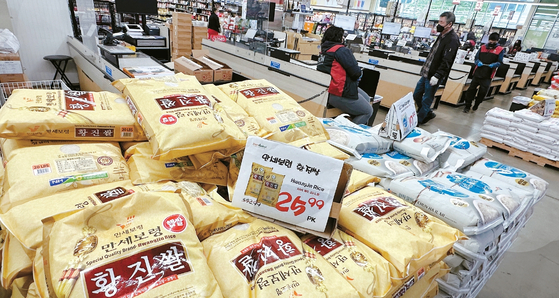
According to data from the Korea Agro-Fisheries & Food Trade Corporation Los Angeles (aT), the volume of rice exports to the United States from 2021 to 2022 jumped 285.5% from 514 tons in 2021 to 1,843 tons. The export value also increased 136.1% year-on-year to $3.97 million.
Compared to the first half of last year, when the volume of rice exports to the United States increased by 21.9% from 270 tons in 2021 to 329 tons in 2022, it is understood that the second half of the year saw a record increase in rice exports.
The heatwave and severe drought in California caused the price of rice in California to surge. In South Korea, on the other hand, a glut of rice caused prices to plummet, forcing the country to seek new avenues for rice exports, explaining the surge in exports to the U.S. in the second half of the year.
Korean local governments participated in the Agriculture and Fisheries Expo, a four-day event held at the Korean American Festival in Los Angeles last September. In particular, Jeonnam, Gyeongsangbuk-do, Jeonbuk-do, and Gangwon-do signed memorandums of understanding (MOUs) with Korean-American markets to explore export markets for agricultural and fishery products in the Americas, and sought to export rice, which also contributed to the increase in Korean imports to the United States.
“The price difference between U.S. rice and Korean rice has narrowed significantly, which has led to an increase in purchases,” said a representative from the Korean-American market industry. “Increased preference for premium rice also seems to have contributed to the increase in rice demand.”
After rice, soju, the second largest Korean export to the U.S., grew 42 percent year-on-year. In the past, soju was popular as a cocktail liquor, but recently, thanks to the Korean Wave, it has become more popular among non-Koreans.
In addition, tuna (33.7%), processed rice (28.4%), ice cream (25%), pears (16.4%), gochujang (10.8%), and oysters (10.4%) increased their export volume from Korea.
Kimchi, which has been attracting attention as a ‘health food’ after the establishment of California’s Kimchi Day in 2021, also increased by 3% year-on-year. The export value was $29 million. Meanwhile, the annual export value of kimchi to the United States has steadily increased from $9 million in 2018 to $14.8 million in 2019, $23 million in 2020, and $28.3 million in 2021. Rice processed foods, such as instant rice and cup tteokbokki, increased by 28.4% to $86.5 million as home-made meals (HMRs) are popular among the MZ generation, who have begun to show interest in K-food.
However, ginseng and instant noodles, which benefited from the COVID-19 pandemic, were down year-on-year.
According to aT, Korean food exports are expected to grow steadily due to its positive reputation as a healthy food, excellent flavor and quality, diversification of sales to multiethnic markets and online, and high interest in K-food.
In 2022, total Korean food exports to the U.S. were valued at $1.632 billion, down slightly from $1.655 billion in 2021. Despite the decline in overall exports, the value of seafood exports to the U.S. increased by 7.9% year-on-year to $424 million.
BY LEE EUNYOUNG




